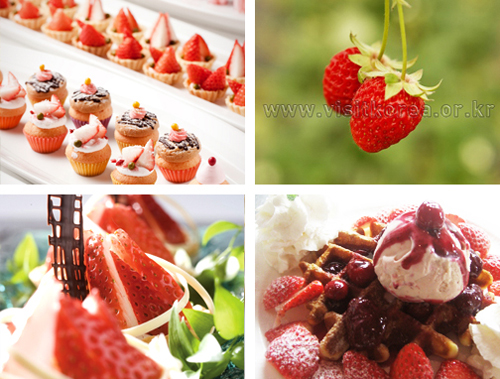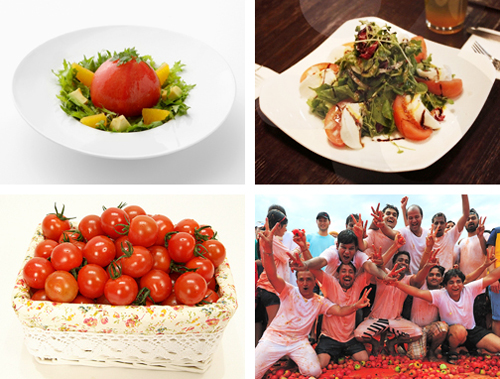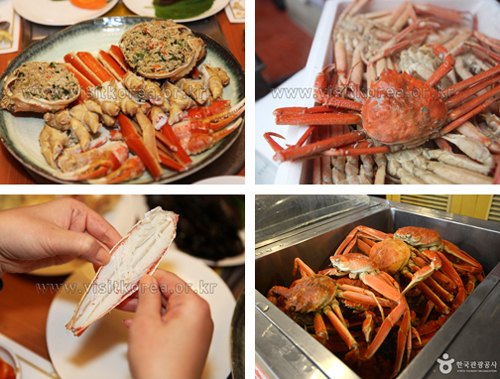Popular Spring Foods in Korea
Popular Spring Foods in Korea
Korea is marked by four distinct seasons and Koreans have traditionally believed that eating fresh seasonal foods in the spring help them to stay healthy throughout the year. As a matter of fact, seasonal foods are highly nutritious, so they help boost your immue system and also have the best flavor when in season. In spring, many festivals are held to showcase regional spring foods, drawing large crowds of tourists to try the freshest spring foods. So, try delicious spring fruits, vegetables, and seafood to boost your energy!
**Tender Jukkumi
Jukkumi, or octopus ocellatus, is about 10 to 20 centimeters smaller than the common octopus. The common octopus has a firm texture, and one of its eight legs is longer than the others, but jukkumi has a tender texture and eight limbs of the same length. Jukkumi is mostly caught from October to May, but it tastes best in the spring when its head is filled with eggs. Jukkumi eggs are very much like rice in terms of color, shape, and size, and they have a mild, yet delicious taste.
- ☞ Food
- 1. Jukkumi Samgyeopsal Bokkeum: This food features jukkumi and samgyeopsal (grilled pork belly) seared quickly with vegetables and rice cakes in a hot and spicy red chili sauce. When you’re finished with the jukkumi, you can ask for rice to be fried in the pan with the remaining sauce. Restaurants can be found in busy commercial districts in big cities or on the west coast.
2. Jukkumi Shabu-shabu: This variety of jukkumi is cooked in a clear vegetable broth for a tender and slightly chewy taste. Knife-cut noodles or dough flakes roughly torn by hand can be added later. The broth is savory, plain, and not too spicy, so the dish can be enjoyed by all. Many restaurants specializing in jukkumi shabu-shabu can be found on the west coast where a large number of jukkumi is caught. - ☞ Effects
- Jukkumi is rich in taurine, so it is good for relieving fatigue. Its high content of unsaturated fatty acids like DHA helps lower blood-cholesterol levels. It is also a low-calorie food that is high in essential amino acids, making it great for weight loss.
- ☞ Production Region
- Jukkumi is caught in many parts of Korea’s sea, but mostly on the west coast in areas like Seocheon, Taean, and Boryeong in Chungcheongnam-do.
- ☞ Jukkumi Festivals
- Seocheon Camellia Octopus Festival
Muchangpo Mystic Sea Road Jukkumi and Dodari Festival
**Fresh King Crab
From February to mid-March is the best time to eat king crabs. Mostly caught off Korea’s east coast, King crabs are so delicious that they used to be specially presented to kings during royal banquets.
- ☞ Food
- Daege-jjim: In general, king crabs are steamed whole. They can then be broken into easy-to-handle pieces. Usually, rice is mixed in the head shell with the delicacy called “crab butter.” There are king crab restaurant streets in Uljin and Yeongdeok in Gyeongsangbuk-do such as Yeongdeok Crab Village. King crab restaurants can also be found in busy commercial streets in big cities like Seoul and Incheon.
- ☞ Effects
- Daegae, or king crab, is high in protein and calcium. Though it has a high content of essential amino acids, it is low in fat. King crab eggs are high in nucleic acid, which has anti-aging effects and is good for the skin.
- ☞ Production Region
- Uljin and Yeongdeok in Gyeongsangbuk-do are quite famous for their king crab. In Uljin, you can buy king crabs at lower prices than in Yeongdeok, since more king crabs are caught there. However, king crabs from Yeongdeok are considered to have a better flavor as they live in cleaner sands.
- ☞ Crab Festivals
- Uljin Snow Crab & Red Snow Crab Festival
Yeongdeok Snow Crab Festival
**Healthy and Fresh Spring Vegetables
As the earth begins to warm in the spring, plants across Korea begin to sprout. There are many different spring vegetables in Korea, including ssuk (mugwort),gondeurae (cirsium setidens), gosari (bracken), dalle (wild chive), and naengi(shepherd’s purse). These spring greens are packed with nutrition and help make for a well-balanced meal.
- ☞ Food
- 1. Side dishes: Spring vegetables are fragrant and tender, so it is best to blanch them in boiling water and then season them. Because they are widely available and the prices are affordable in the spring, these vegetables are common side dishes at Korean restaurants. Visitors can taste a variety of spring vegetables dishes in Korean hanjeongsik restaurants like Doore [Best Korean Restaurant designated by the Seoul Metropolitan Government].
2. Soup: In the spring, many restaurants serve soup made of spring vegetables such as dodari-ssukguk (soup made of dodari (ridged-eye flounder) and mugwort), dalle-doenjangjjigae (soybean paste stew with wild chives), andnaengi-doenjangguk (soybean paste soup with shepherd’s purse). Dodari-ssukguk is often served in restaurants on the southern coast. It can also be had in fresh raw fish restaurants in big cities.
3. Bibimbap: A major Korean dish featuring spring greens is bibimbap. In Korean homes, it is quite common to for this dish to be made. In restaurants, people can have bibimbap with bracken, mugwort, and cirsium setidens. - ☞ Effects
- Many spring vegetables are rich in vitamin B and minerals, which are important for metabolism.
- ☞ Production region
- Spring vegetables grow in the mountains and fields throughout Korea. Mugwort, especially of Ganghwa-do, are considered to be particularly healthy because they grow in clean soil in an ocean climate (the temperature variation is small and the humidity high due to the sea).
- ☞ Festivals
- Ganghwa Mugwort Festival
Pyeongchang Cirsium Setidens Festival
Hallasan Gosari Festival
Yongmunsan Wild Herbs and Vegetables and Korean Beef Festival
**Sweet Strawberries
 [Photo Credit: https://www.sheratonwalkerhill.co.kr]
[Photo Credit: https://www.sheratonwalkerhill.co.kr]
Strawberry season in Korea takes place between March and April. With their bright red color, sweet flavor, and mouth-watering aroma, strawberries are always a big hit. They also have various medicinal benefits.
- ☞ Food
- With the arrival of spring, a variety of strawberry promotions are offered at famous hotels in Seoul, like the Sheraton Grande Walkerhill, Sheraton Seoul D Cube City Hotel, and the Novotel Ambassador Gangnam, Seoul. The promotions are buffets featuring a variety of strawberry dishes.
- ☞ Effects
- Strawberries are an excellent source of vitamin C. Per serving, it has 1.5 times more vitamin C than a mandarin orange, and 10 times more than an apple. So, it is good for preventing brown spots or freckles that develop by excessive or repeated exposure to the sun in the spring and helps prevent the skin from aging. Strawberries are high in potassium, helping to discharge body waste and help keep skin healthy.
- ☞ Production Region
- Strawberries are produced in warm southern regions in Korea, like Damyang in Jeollanam-do, Nonsan in Chungcheongnam-do, and Geochang in Gyeongsangnam-do.
- ☞ Strawberry festivals
- Nonsan Strawberry Festival
Yangpyeong Strawberry Festival
Wanju Samnye Strawberry Festival
Samnangjin Strawberry Festival
**Juicy Tomatoes
 [Photo Credit: https://www.celeb-de-tomato.co.kr]
[Photo Credit: https://www.celeb-de-tomato.co.kr]
Selected as one of the New York Times’ top 10 foods, tomatoes are both delicious and good for your health. Lycopene, a bright red carotenoid pigment, and phytochemicals are found in tomatoes, and these reduce the chance of developing cancer, relieve fatigue, and aid the digestive process. Tomatoes, which are low in calories, are effective for diets. In Korea, different varieties of tomatoes, such as cherry tomatoes, are produced.
- ☞ Food
- Tomato can be eaten raw or sliced to pair with a sandwich or salad. It is also a base for spaghetti and pizza sauce. A great place to taste a variety of tomato dishes is Celeb de Tomato, a restaurant specializing in tomato dishes.
- ☞ Effects
- Lycopene is an antioxidant compound that gives tomatoes their red color. Tomatoes have anticancerous effects and eating tomatoes over a long period helps relieve fatigue and cleanse the body. Tomatoes are a low calorie food, so it is great for weight loss. Cooked tomatoes also help prevent skin aging.
- ☞ Production Region
- Tomatoes produced in the Daejeo area of Gangseo-gu, Busan, have a great taste and aroma and are exported overseas. Every year a tomato festival is held in this region.
- ☞ Tomato Festivals
- Busan Daejeo Tomato Festival
Gwangju Toechon Tomato Festival
Hwacheon Tomato Festival
https://english.visitkorea.or.kr/enu/SI/SI_EN_3_6.jsp?cid=713941



